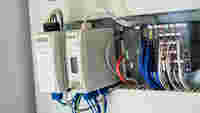New Monitoring Technology at the Förmitztal Dam

Advantages of the WAGO-I/O-SYSTEM 750:
- Fine-grained modularity and fieldbus-independence
- The XTR variant is also suited for use in extreme conditions
- Powerful, flexible and reliable

The Förmitztal dam primarily functions to prevent low water levels on the Saale river, whose source lies only a few kilometers southwest of the dam near Zell at the foot of the Waldstein mountains. The river flows north towards the city of Hof, located around 18 kilometers from the dam. The Förmitz reservoir is supplied by a bypass from the Saale, the Förmitz watershed, and a tributary of the neighboring Lamitz river. The key control level for the Förmitztal dam is located in Hof. During periods of low precipitation, normally between July and September, discharge of at least one cubic meter per second must be ensured to control water pollution and ensure that the water level is high enough at the discharge point for the Hof wastewater treatment plant. Therefore, the water authority discharges approximately four million cubic meters of water annually.
In addition to preventing low water levels on the Saale, the dam also contributes to flood prevention. Since 1991, the water discharge has also been used for energy production following the installation of a turbine. On average, the dam generates around 400,000 kWh annually, which is equivalent to the annual consumption of 125 households. In addition, the water reservoir is also used for recreation – swimmers, boaters and divers enjoy the facility. Significant modifications were made to the measuring equipment in the main dam in 2014. “Up to this point, we measured the levels manually once a week. However, the measuring points were sometimes not accessible in winter, because they were either snowed in or frozen,” explains Matthias Sudholt, who monitors the technology at the dam with his colleagues. A fiber optic cable ring was installed alongside the dam in 2014. Since then, the WAGO-I/O-SYSTEM 750 has recorded the levels and transmitted them to the control center in the operating building of the dam. Here the data is administered and visualized on a panel. An additional expansion of the network is planned for the future.
The fiber optic network connects the control center to seven additional points alongside and within the dam. These include important interconnection points: the two access points to the inspection tunnel, the Förbau level indicator and the external discharge. There are also measuring points on the shutter in the surge chamber, which is located deep inside the dam and, in combination with the turbine controller, controls the outflow of the water out of the dam into the Saxon Saale. The power house and generator are also part of this. At the deepest point in the inspection tunnel, the seepage into the sump pit is measured, among other variables.

The WAGO-I/O-SYSTEM 750 XTR also performs reliably when severe weather leads to dangerous increases in potentials at the reservoir.
A total of 40 measuring points for controlling groundwater levels are located on the water and/or air side of the dam. Measurement values, which were previously recorded manually, are now routed through the fiber optic network to various nodes. Data collected at the nodes are supplied to the WAGO-I/O-SYSTEM 750 via an ETHERNET switch and transmitted to the control center, where they are recorded and visualized. The dam also includes 30 measuring points for monitoring the water pressure. This data is still collected on site at this time. The long-term goal of the water authority, however, is the automated transmission of all measured data through the network to the control center. At the center, as well as at various stations, it can be visualized and controlled at a panel on site.
The data from even more remote measuring points is currently transmitted by radio to the control center and supplied to the I/O System 750. It includes the water levels of the Saale in Weißdorf and Hof, the flows from the Förmitz and Lamitz tributaries into the reservoir, the water level in the reservoir itself and the residual water volume in the Lamitz river. The data keeps the Hof water authority informed at all times about the operating condition of the dam and the status of the Saxon Saale. Mobile measurement boxes are occasionally used to record data at measuring points in and around the dam that do not require continuous monitoring. The data recorded by the box is stored locally on the controller and transmitted via Bluetooth® to the nearest control cabinet. In addition to the Bluetooth® antenna, a WLAN gateway is installed at the box. This gateway connects to the WebVisu for access to the measured data on site.
Extreme ambient temperatures
Immunity to electromagnetic interference and impulse voltages
Vibration and shock resistance
Explosion protection